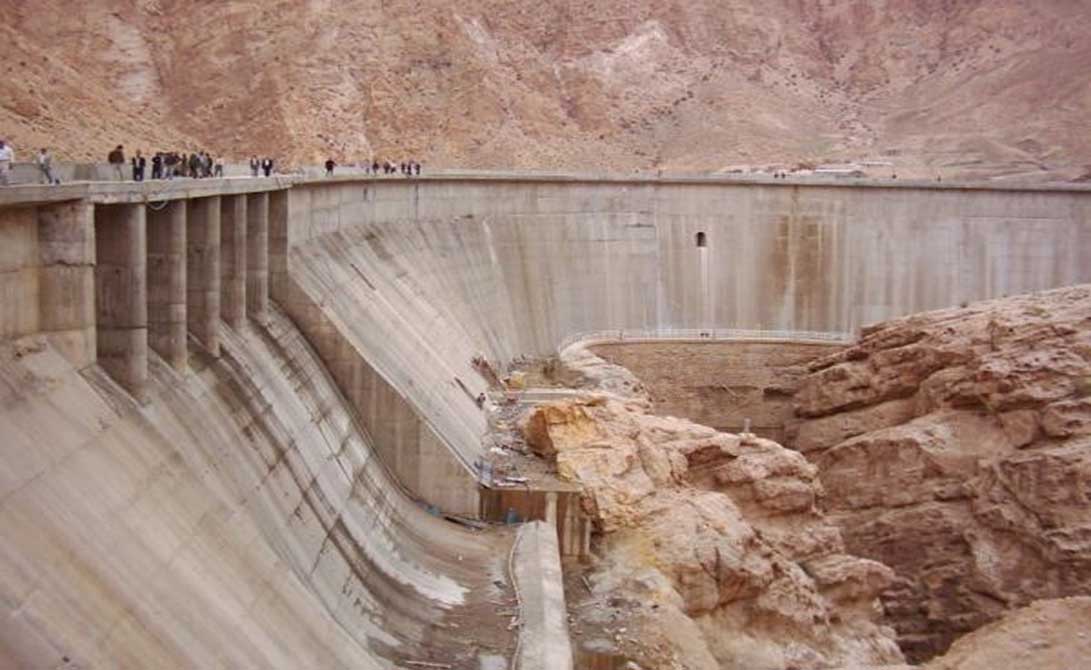Kurit Dam
Profile; ?>The dam is located in the Northeast of Kurit Village, 42 km away from Southeast of Tabas. From the mid-14th century until the beginning of the 20th century, Kurit Dam was considered as the highest dam in the world. In other words, this dam has the record of being the highest dam in the world for 550 years, and no other dams in the world have had such record yet. Kurit Dam is a sample of arch-gravity dams in ancient Iran, which was built in the middle of a very narrow valley, in a mountainous region.
Kurit Dam supplied water for Kurit Village for more than 600 years, by regulation of Kurit River. The distance between village and dam site is approximately 26 km, of which 5 km is in a very narrow valley, with hard accessibility. Therefore, it requires more than 10 hours of hiking to approach to the dam site. Construction of the dam in an area with hard access shows that all possible point for dam site has been studied by that time, and the current location is the best alternative. In 1978, a devastating earthquake ruined the village, however, surprisingly the body of the dam was not considerably damaged. This event shows that high-quality materials were used for the construction of the dam body.
History
Kurit dam was constructed in 4 stages, and the last stage was in 1941 when the height of the dam was increased by 4 meters. Construction in 4 phases, with considering sediment formation, has had a significant role in operational age of the dam. In 550 years, the exceptional height of dam (54 m), had been a record, which is one of the wonders of that era. The dam is 50 m long and 2.1 m wide. The astonishing point about Kurit dam is using intake outlets to discharge from different levels of the reservoir, and discharging sediments that shows the ingenuity of the people who constructed the dam. Unlike the gravity dams, downstream of the structure is upright and upstream is oblique, and the reason is the difficulty in accessing downstream of the dam. Like other ancient dams of Iran, Kurit Dam was built with stone and mortar. The bricks are square with 37cm in the dimension that were used in the last stage of construction. The dam regulated water of Kurit River to irrigate farms of Kurit Village. After passing the dam, the river flows down in a narrow valley in 5 km, and then enters the plain. Due to accumulation of sediments in the reservoir and impossibility of operation, in 1998 a concrete dam was built in upstream of Kurit Dam, to harness the floods and protect the old structure, which is currently under operation. Performance of Kurit Dam in Centuries, as well as its stability for 700 years, demonstrates that the knowledge and expertise of that era was exceptional, which can be an inspiring resource for structural engineering in the present.
Project System and Heritage Composition
Kurit Dam is a result of teamwork and a high level of accordance. The fact that residents of Kurit Village had the role of employer, consultant, contractor, operators and user at the same time, is a clue of taking advantage of a team including multidisciplinary specialists in value engineering. After construction of the dam floods and the current from upstream wells could be stored, and considering that the reservoir was surrounded by mountains, the evaporation was minimum.
With 64 meters in height and 2.1 meters in width, Kurit double-arch dam had been the highest dam in the world for 550 years, till the early 20th century. The method of dam construction was a brilliant engineering achievement 700 years ago and it still is. Moreover, using the intake tower to decrease the velocity of flow is an exceptionally innovative sample, and intake of water utilizing intake tower shows the ingenuity of engineers in that era.
Building the dam in stages based on temporal demand is the best example of applied value engineering in water resource projects. Using appropriate materials has prevented from any destructions during operation years, despite considerable numbers of floods. Furthermore, after the disastrous Tabas earthquake in 1978 that led to 25,000 fates, there were no cracks in the dam body. The genius of architects in deciding the location of constructing the dam in a section of the valley that resulted in a 50 meters length and 64 meters height, is a point that contemporary dam architecture studies in the 90s admired.
The costs for diversion system, flood discharge and diaphragm has decreased to zero. Additionally, dimensions of the structure were selected by the minimum possible and constructing the dam in stages distributed the costs during the years. Therefore, peripheral costs were minimized in the project, which indicates the vision of architects about the costs of depreciation.
Present State of Conservation
The appearance of the dam is appropriate, while needs some repairs. Considering that a new dam was constructed in upstream of Kurit Dam, and hence the old dam is not under operation, measures should be taken to ensure from the stability of the dam. To do so, initial actions have been taken by the regional water authority of Khorasan.
HIGHLIGHTS
Country: Iran
Province: South Khorasan province
Latitude : 33.484382783042236 Longitude : 56.43419298750004
Built: Approx. 1397 (800 Lunar Hegria)
River: Kurit River
Irrigated Area: 245 Ha
70th IEC Meeting, Bali, Indonesia, 2019




